Finding House and Home
It was a hot afternoon in August. As I stood in the dark attic, the heat rose and hung densely while I bantered back and forth with a carpenter about options for the mostly finished attic of the house I’d just bought. He laid out options ranging from a total finish out with the installation of a window—a nice idea but never going to happen on my budget—or the less expensive and more likely option of just leaving things exactly as they were. In the end, we met somewhere in the middle.
- Author in the midst of house renovation
- Picture window in the author’s house
While shining our flashlights in the dark corners of the attic and trying to assess the best way forward, we stumbled upon a small cache of objects overlooked by the previous owners. Their task of emptying the house was mammoth, clearing a house in which their parents lived for almost 60 years. The few objects we found between rafters were minor in the scheme of things. Small things, as it were, but signs of a life that ultimately said so much: a discarded datebook; surplus Valentines from decades long ago, unsigned and still in their original packaging; cassette tapes; a program from a Christmas pageant circa 1979; many small, discarded remnants of childhood play; and a few stray socks for good measure.
As a single mother, I recognized these objects as the natural and loving detritus of life. Because I knew the children of the previous owners, anything that seemed significant was photographed and returned, like a hidden stash of kitchen platters found tucked in a remote cabinet. The datebook I found in the attic that day particularly captured my imagination. I could imagine the bridge groups and camping trips and birthdays that populated the pages. And the rare diversions and delights: “Madame Butterfly” penciled in for a night in April, and “Rigoletto” slated for one evening in June. There were mysteries too: Who was Dr. Rogers and why these persistent appointments?
Encountering these mementos from another family primed my heart for my own encounters with my family’s past, the kind of encounters that wait in the cracks of an attic or the depths of a filing cabinet or bottom of a drawer. My parents began their own downsizing about six months after I moved into my house, and the treasure trove of memories they’d accidentally buried, or perhaps intentionally forgotten, are still unfolding for us. Many of the things we’ve unpacked, unboxed, and shuffled from their home of over fifty years were left in boxes from their own parents.
There were poignant letters home detailing the ups-and-downs of family life that my mother wrote to my grandparents, all of which were lovingly kept by my grandmother and then equally lovingly collected and redistributed by my aunt as she took on the enormous task of dismantling and clearing my grandparents’ home in 2002. Like my house, their home was also a midcentury marvel, a loving vision of big family life made real by an avant-garde Alabama architect named Charles Minch. It was Bauhaus-inspired and highly functional. My grandfather, an introverted medical doctor, rigged a state-of-the-art sound system in the house so he could read bedtime stories to all six of his children at one time from the comfort and quiet of his office on the first floor, and pipe classical music into their rooms as a way of sharing his passion with them equitably while still protecting his limited social energy for his clinic patients and house calls.
Another letter I stumbled upon was one written to my great-grandmother by the younger sister of a gentleman whose name I’ll never remember, and face I never saw, but who, along with my great-uncle, undertook a suicide mission at the Battle of Midway. My great-grandmother went to considerable lengths to establish a network of contact between the families of the young men who flew on that mission. She was determined to learn as much as she could about the mission details and the men who flew with her son, hoping desperately that enough information might either confirm or dissuade her hope that one day her son would return home. Perhaps if someone’s plane were recovered, or a body were found, or they’d made contact with the French Resistance, her grief might abate, if even for a brief, hopeful minute.
To this end, she became an avid correspondent with many of the families who also had sons in his squadron. One can hear both the grief and the persistent hope in the letter this particular young woman penned to my great-grandmother. Aware of her own mother’s overwhelming sense of loss, she wrote with understanding and encouragement as both mothers approached their first Christmas without their sons. Almost eighty years later, I read her words and felt moved that this young woman in Michigan would send such a kind and personal letter to a grieving mother in Montgomery, Alabama, whom she had never met, but who shared a connection to her home, or the sense of home forever altered. She reached out with love to remind my Gran that sometimes our homes are as big as our hearts, with rooms to expand and grow even when the new expansion is predicated by uninvited guests.
Just blocks away from the home in which that same woman spent the remainder of her life dutifully corresponding with families she never knew, about boys she never met, regarding a son she would never see again, her still-living son, my grandfather, slowly built his own life. He married a local girl, a firecracker of a wife, and they went on to have six children. He maintained a deep sense of duty to his medical practice and to the community until his heart gave out one morning while shaving. My grandfather loved classical music and the opera. When I saw the journal entry from the abandoned datebook in my attic that listed a performance of “Madame Butterfly,” I thought of him.
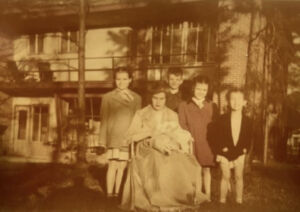
Author’s grandmother and her children in front of their home
Sometimes home feels much less concrete than the four walls we imagine containing it. Often it feels much more like a series of elliptical realities, realities in which our sense of home interweaves and overlaps with the realities of others. Sometimes those moments of overlap and connection feel like a portal, and sometimes merely a shared delight or synchronicity. There is mystery in this, and a calming sort of certainty as well.
***
Years passed, children left home, some came back, and others kept their distance. Grandchildren entered the story; these days, not too far from my great-grandmother’s house, my first cousin tends to bees. Deeply connected to nature, like her mother before her and the grandmother we share, her life and love brought her out of the city and into the surrounding county. The land there is green and lush, covered with the red dirt that is synonymous with central Alabama and nurtured by the nearby banks of the Coosa River. I visited her hives a few summers ago. It was weeks after a death in her family, and I noticed candles stashed around the hives as well as a scattering of ribbons tied on or close to the hives themselves. She explained that she’d needed to tell the bees of the recent death, and a small group gathered to make a memorial out of the occasion.
Apparently, the practice of “telling the bees” when a loved one has died, particularly if the deceased individual was the beekeeper or intimately connected to the hive, is considered essential for the colony’s continuity and thriving. Bees must be informed of a death, otherwise the beekeeper runs the risk of death within the colony or the bees abandoning the colony altogether. The tradition originated in Western Europe hundreds of years hence, though the concept of bees as representatives of the divine dates back to ancient times, with many early civilizations imagining bees as messengers between the living and the dead.
Like all living creatures, bees themselves have their own ways of dealing with death, albeit much more head on. Certain bees are tasked with the function of “undertakers” for the colony, routinely removing death from their own ranks and politely depositing the deceased bee outside the walls of the hive. In a perhaps unsurprising parallel, undertaker bees, which make up only 1–2% of a population, are generally middle-aged worker bees. I’ve recalled this fact many times over the past few years as the objects, mementos, and artifacts of past lives continue to weave in and out of my midlife experience on a daily basis. Whether they’re in the cracks of the attic rafters, or the bottom of my father’s very organized and very heavy 1960s metal file cabinet, the ominous task of helping to manage the slow dissolution of a material life is always an undertaking. Stewarding the objects of a loved one’s life into the hands of scattered relatives, trusted friends, and the blessed Goodwill is always a job, and on good days also a joy. In this, I feel a connection to those bees.
***
I was recently back in Montgomery, where most of these stories intersect, as my cousins and I aided in the sorting and moving process that unfolded after my uncle’s death. His partner of over thirty years, a saintly man from rural Tennessee with a soft-spoken voice, could hardly contain his delight at parting with my uncle’s record collection, or treasured books, or hundreds of vases and dishes that had gotten scant use in the final years of his life, curbed by a rapid progression of illness and incapacitation caused by Parkinsons. His partner wanted nothing more than to find my uncle’s treasured objects a happy home. After so many years of watching people move, fret, and organize a life around the material world within their houses, it was deeply refreshing to be around someone who felt so little connection to the things that many people mistake for a life, or in this case, a home.
Instead, the one thing he never offered to part with, and made sure to share with my cousins and I, was a cherished letter that my uncle wrote to him in the last year of his life. It was an expression of love and gratitude, a recognition of both the challenges and imperfections in their relationship, as well as the joys and simple pleasures. The letter recognized the fortitude and commitment that they showed to one another, predicated on the sort of compassionate resilience that all long-term relationships require. And perhaps most importantly, it named the hard but true fact that life does go on. Even when our home is a person, that person is as impermanent as the structures that he or she inhabits. His instruction to his partner was clear: Keep going. There is more. Don’t stay here. What we built together will be your home, and in that home there will be room for more life, more people, more love.
***
The carpenter and I came to a compromise, and every day I’m grateful for my mostly finished attic. I’m grateful for the beauty of the house I call my own, but mostly I’m grateful for my home. And home is more than a place, it’s a feeling. And it’s not one we build alone. My favorite antidote about the house I bought is from the woman who lived across the street from the previous owners for almost thirty years. She told me that most nights, as the evening fell, she would look out her front window and see the family in the living room, sitting together in front of the big picture window that faces due west and frames the sunset as if it were some subtle, evolving master work. Both parents would sit with their three children as the day closed, and she marveled at both their joy and their consistent devotion. My predecessors cared for a house but built a home, and ultimately, it was big enough to make room for others. And every day, I thank them.
- Previous owners, Christmas Day 1975
- Previous owners outside the garage


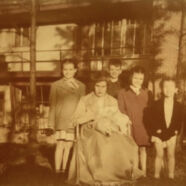





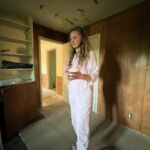


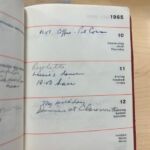
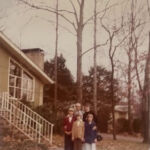

The author, Martha Lynn Coon, is my sister’s child. She was always upbeat and pleasant with great communication skills. She is obviously a gifted writer. I loved reading about family experiences and feelings. Martha Lynn has plenty of material to write a book on our Brannon family. I hope she some day seizes that opportunity!